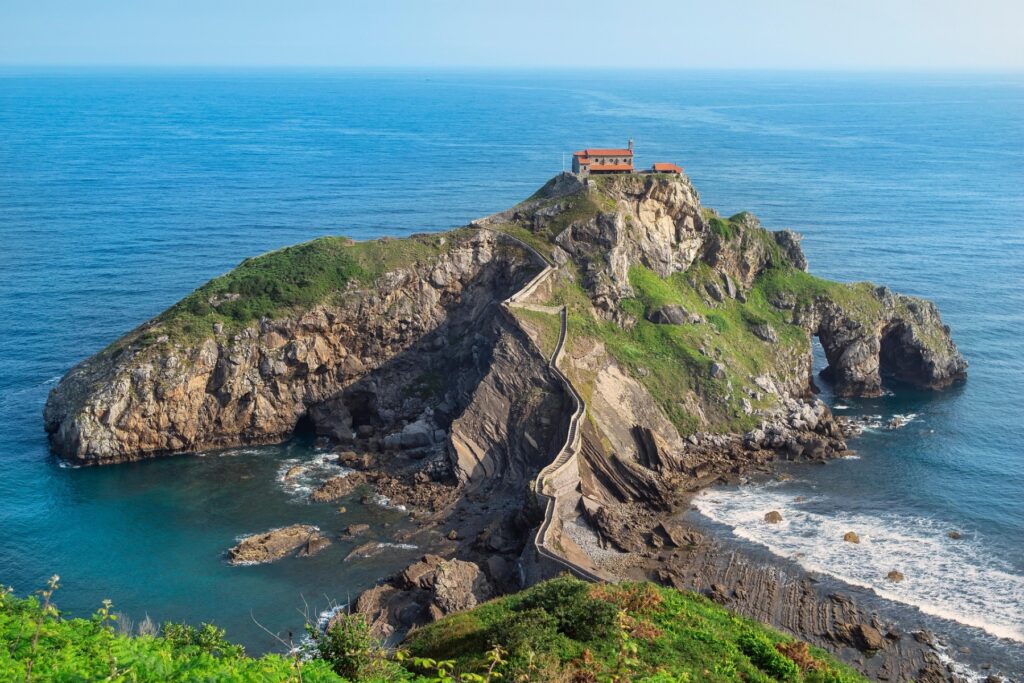The Northern Basque Country, often referred to as the French Basque Country, is a captivating region in southwestern France, nestled along the Bay of Biscay and bordered by the western Pyrenees Mountains. It forms the northern part of the larger cultural region known as Euskal Herria, a historic and cultural territory that also encompasses parts of northern Spain. This area, steeped in rich history, unique traditions, and a distinct linguistic heritage, offers a fascinating blend of natural beauty, cultural vibrancy, and historical significance. In this exploration, we delve into the geography, culture, history, and contemporary life of the French Basque Country, emphasizing its coastal connection to the Bay of Biscay and its mountainous backdrop in the western Pyrenees.
French Basque Country Geography and Natural Beauty
The French Basque Country, known in Basque as Iparralde (meaning “northern side”), spans approximately 2,900 square kilometers in the Pyrénées-Atlantiques department of southwestern France. It comprises three historical provinces: Labourd (Lapurdi), Lower Navarre (Nafarroa Beherea), and Soule (Zuberoa). The region is defined by its dramatic geography, with the rugged peaks of the western Pyrenees Mountains forming a natural border with Spain to the south and the wild, windswept coastline of the Bay of Biscay to the west.
The Bay of Biscay, a gulf of the Atlantic Ocean, shapes the French Basque Country’s western boundary, creating a coastline renowned for its beauty and power. Stretching from the chic resort town of Biarritz to the quaint fishing village of Saint-Jean-de-Luz, the coast features sandy beaches, rocky cliffs, and pounding surf that attracts surfers, tourists, and locals alike. The bay’s turbulent waters have historically challenged mariners, earning it a reputation as a formidable maritime region, yet its scenic allure is undeniable. Towns like Hendaye mark the border with Spain, where the Bidasoa River meets the sea, creating a natural frontier.
To the south and east, the western Pyrenees rise sharply, their green slopes and jagged peaks providing a stunning contrast to the coastal plains. Mountains like La Rhune, a sacred site in Basque mythology, offer panoramic views of both the French and Spanish Basque regions. The Pyrenees not only serve as a natural barrier but also as a cultural crossroads, linking the French Basque Country with its southern counterpart in Spain. This geographic diversity—coastal vibrancy paired with mountainous serenity—makes the French Basque Country a haven for outdoor enthusiasts, from hikers and climbers to surfers and sailors.
Cultural Identity and Euskal Herria
The French Basque Country is an integral part of Euskal Herria, the broader cultural and historical region that transcends modern political borders. Euskal Herria, meaning “the land of the Basque people” in the Basque language (Euskara), includes the French provinces of Labourd, Lower Navarre, and Soule, as well as the Spanish regions of Navarre and the Basque Autonomous Community. The Basque people, or Euskaldunak, are united by their language, traditions, and a deep sense of identity that predates modern nation-states.
Euskara, one of the oldest non-Indo-European languages in Europe, is a cornerstone of Basque identity. In the French Basque Country, efforts to preserve and promote Euskara are evident in bilingual schools (ikastolas), cultural festivals, and media. Organizations like Euskaltzaindia, the Royal Academy of the Basque Language, work to standardize and promote the language across Euskal Herria. While French is the dominant language in public life, Euskara remains a vital expression of cultural pride, particularly in rural areas like Soule, where traditional songs and dances, such as the Zuberoako Maskarada, are performed.
The French Basque Country’s cultural landscape is enriched by its festivals, cuisine, and sports. The Fêtes de Bayonne, a week-long celebration in Bayonne, draws thousands with its music, bull-running, and vibrant street parties, reminiscent of Pamplona’s San Fermín festival across the border. Basque cuisine, featuring dishes like axoa (a veal stew), piperade (a pepper-based dish), and gateau Basque (a custard-filled pastry), reflects the region’s agricultural and maritime heritage. The Bay of Biscay provides fresh seafood, while the Pyrenees offer lamb, cheese, and wines like Irouléguy, produced in the vineyards of Lower Navarre.
Pelota, a traditional Basque sport, is another cultural hallmark. Played in frontons (open-air courts) across the region, it involves players hitting a ball against a wall with their hands, rackets, or baskets. The sport’s popularity underscores the Basque emphasis on community and physical prowess, with matches often accompanied by local festivities.
History of The French Basque Country
The history of the French Basque Country is intertwined with the broader history of Euskal Herria, shaped by its strategic location between France and Spain. The region’s provinces have distinct historical trajectories. Labourd, with its coastal towns, was a hub of maritime activity, with whalers and fishermen venturing into the Bay of Biscay as early as the Middle Ages. Lower Navarre was once part of the independent Kingdom of Navarre, which straddled the Pyrenees until its division in the 16th century. Soule, the smallest and most isolated province, retained its pastoral traditions and distinct dialect of Euskara.
The French Basque Country became part of France following the Treaty of the Pyrenees in 1659, which formalized the border between France and Spain along the Pyrenees. Despite this political integration, the Basques maintained their cultural autonomy, with local laws (fors) governing community life until the French Revolution centralized authority. The 19th and 20th centuries saw economic shifts, with industrialization in coastal towns like Bayonne and tourism booming in Biarritz, once a favorite retreat of European royalty.
The 20th century also brought challenges, including the decline of Euskara due to French assimilation policies. However, the late 20th century saw a cultural revival, with movements advocating for Basque language education and regional recognition. In 2017, the French Basque Country achieved a milestone with the creation of the Agglomération Pays Basque, a regional administrative body that fosters cooperation among Basque municipalities, strengthening local governance and cultural preservation.
Contemporary Life and Tourism
Today, the French Basque Country is a vibrant region that balances tradition with modernity. Its coastal towns along the Bay of Biscay are major tourist destinations. Biarritz, with its elegant beaches and world-class surfing, attracts an international crowd, while Saint-Jean-de-Luz offers a more intimate seaside experience, with its historic harbor and charming streets. The region’s proximity to the Spanish Basque Country, particularly cities like San Sebastián, makes it a gateway for cross-border exploration of Euskal Herria.
Inland, the Pyrenees draw adventurers and nature lovers. Villages like Espelette, famous for its red chili peppers, and Ainhoa, a picturesque hamlet, showcase traditional Basque architecture with whitewashed houses and red or green shutters. The region’s rural charm is complemented by its hiking trails, such as those in the Vallée de Nive, which wind through lush valleys and past ancient stone crosses.
Tourism is a major economic driver, supported by initiatives like the Basque Country Tourism Office. Visitors are drawn to the region’s blend of outdoor activities, cultural immersion, and gastronomic experiences. The French Basque Country also benefits from its accessibility, with Biarritz’s international airport and high-speed rail connections to Paris and Bordeaux.
Challenges and Future Prospects
Despite its cultural richness, the French Basque Country faces challenges. The decline of Euskara remains a concern, though revitalization efforts are gaining traction. Economic pressures, including the high cost of living in coastal areas, pose challenges for younger generations, many of whom move to urban centers like Bordeaux or Toulouse. Additionally, the region grapples with balancing tourism with environmental preservation, particularly along the ecologically sensitive Bay of Biscay.
Looking ahead, the French Basque Country is poised to strengthen its role within Euskal Herria through cross-border cooperation with the Spanish Basque regions. Projects like the Euroregion Aquitaine-Euskadi-Navarre promote economic and cultural ties, fostering a shared Basque identity. The region’s commitment to sustainability, cultural preservation, and innovation ensures that it remains a dynamic part of both France and Euskal Herria.
Regional Notes
The French Basque Country, with its stunning Bay of Biscay coastline and majestic western Pyrenees, is a region of profound cultural and natural significance. As part of Euskal Herria, it embodies the resilience and pride of the Basque people, whose language, traditions, and way of life continue to thrive. From the surf of Biarritz to the peaks of La Rhune, the French Basque Country offers a tapestry of experiences that captivate visitors and inspire locals. Its unique position at the crossroads of France, Spain, and the Atlantic ensures its enduring allure as a cultural and geographic gem.



















beautiful photos